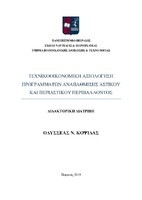Τεχνικοοικονομική αξιολόγηση προγραμμάτων αναβάθμισης αστικού και περιαστικού περιβάλλοντος

Προβολή/
Λέξεις κλειδιά
Cobweb Theorem ; WTP ; WTA ; WTPar ; Οικονομική του περιβάλλοντος ; Πειραματική οικονομική ; Willingness to pay ; Willingness to accept ; Willingness to participateΠερίληψη
Η αποτίμηση μη αγοραίων δημόσιων αγαθών αποτελεί πρόκληση για δύο λόγους: (α) οι κλασικές μέθοδοι αποτίμησης λειτουργούν σε εμπορεύσιμα αγαθά και δεν είναι κατάλληλες για τα μη εμπορεύσιμα καθώς η αρχή προσφοράς - ζήτησης δεν ισχύει και (β) η ποικιλομορφία και η αφηρημένη φύση τέτοιων αγαθών δυσχεραίνουν κάθε προσπάθεια ποσοτικοποίησης οποιασδήποτε ιδιότητάς τους, ενώ πολλές φορές το ίδιο το αγαθό δεν γίνεται άμεσα αντιληπτό από τον πληθυσμό που απολαμβάνει την προσφερόμενη ωφέλεια. Στην παρούσα έρευνα έγινε μια προσπάθεια τροποποίησης και εφαρμογής κατάλληλων μεθοδολογικών εργαλείων στην αποτίμηση τέτοιων αγαθών για χρήση σε τεχνικοοικονομικές αξιολογήσεις προγραμμάτων αναβάθμισης του περιβάλλοντος.
Σχεδιάστηκαν και μελετήθηκαν αρκετά προγράμματα σχετικά με την αναβάθμιση αστικού περιβάλλοντος, προστασίας και αναβάθμισης μνημείων πολιτισμικής κληρονομιάς, αντιμετώπισης της ηχορύπανσης, εξυγίανσης και αναβάθμισης υγροβιότοπων και του περιβάλλοντος χώρου, αναβάθμισης και απορρύπανσης λιμένων και παρακείμενων οικισμών. Η διαφορετική φύση των προγραμμάτων αυτών και η ποικιλία των διαφορετικών παραμέτρων που επηρεάζουν τα υπό εξέταση συστήματα επιβάλλουν μια ευέλικτη και εύχρηστη γενική μεθοδολογία που να μπορεί να προσαρμοστεί κατά περίπτωση. Η Μέθοδος Υποθετικής Αξιολόγησης (Contingent Valuation Method, CVM) είναι μία από τις ευρέως γνωστές μεθοδολογικές προσεγγίσεις για την αποτίμηση μη αγοραίων αγαθών στο πλαίσιο της Πειραματικής Οικονομικής (Experimental Economics).
Η αποτίμηση της προθυμίας των πολιτών να πληρώσουν για να αποκτήσουν ένα ‘χαμένο’ δημόσιο αγαθό μετρήθηκε με την μέθοδο ‘Willingness to Pay’ (WTP). Η μέθοδος αυτή χρησιμοποιήθηκε στην αποτίμηση της βιομηχανικής ρύπανσης στις περιοχές της Ελευσίνας, των Αγίων Θεοδώρων Κορινθίας και της Χαλκίδας. Οι ερωτώμενοι στην περιοχή της Ελευσίνας δείχνουν πιο ευαισθητοποιημένοι και η αντίδραση αυτή σχετίζεται με τον διττό κοινωνικοοικονομικό χαρακτήρα της περιοχής που περιλαμβάνει ένα αρχαιολογικό περιβάλλον και ένα βιομηχανικό περιβάλλον.
Η ίδια μέθοδος χρησιμοποιήθηκε για την αποτίμηση της αισθητικής ρύπανσης που προκαλούν οι απαξιωμένες προσόψεις των οικοδομών στο ιστορικό κέντρο της
Αθήνας και ιδίως στην περιοχή του Θησείου που έχει ιστορικό και τουριστικό ενδιαφέρον. Οι ερωτώμενοι επιζητούν την βελτίωση της υφιστάμενης κατάστασης με ήπια μέτρα και δεν προτιμούν τις ριζικές μεταβολές στο δομημένο περιβάλλον της περιοχής.
Σχετικά με την ανακατασκευή και ανάπλαση μνημείων πολιτισμικής κληρονομιάς, η διαθεσιμότητα των εθελοντών υπολογίστηκε με μία τροποποιημένη μορφή της CVM. Μετρήθηκε η εθελοντική προσφορά εργασίας (Willingness to Participate, WTPar) από στρατιώτες για την ανάπλαση του αρχαίου Διόλκου του Ισθμού της Κορίνθου και του αρχαιολογικού χώρου του Ηραίου στη Σάμο. Οι στρατιώτες υπηρετούσαν την υποχρεωτική τους θητεία και δεν είχαν κόστος ευκαιρίας του χρόνου εργασίας. Διατίθενται κατά μέσο όρο να προσφέρουν 1.5 ημέρες εθελοντικής εργασίας. Η πληροφόρηση σχετικά με την ιστορία του εκάστοτε μνημείου επηρεάζει θετικά την απόκριση των ερωτώμενων.
Οι κάτοικοι κατά μήκος της περιφερειακής οδού Θεσσαλονίκης εμφανίστηκαν διατεθειμένοι να δώσουν χρήματα (WTP) προκειμένου να κατασκευαστούν ηχοπετάσματα κατά μήκων των δύο ρευμάτων κίνησης της οδού για την αντιμετώπιση της ηχορύπανσης.
Αγρότες από την Θεσσαλία και την ευρύτερη περιοχής της Θεσσαλονίκης (ηπειρωτικές περιοχές) και των νησιών της Σάμου και της Ικαρίας (νησιωτικές περιοχές) ερωτήθηκαν πόσο διατίθενται να αποζημιωθούν προκειμένου να διευκολύνουν τη συλλογή και τη μεταφορά της απορριπτόμενης βιομάζας από τις αγροκαλλιέργειές τους. Η αποτίμηση αυτή έγινε με την μέθοδο ‘Willingness to Accept’ (WTA). Κατά μέσο όρο η υπολογιζόμενη τιμή ήταν 2 € ανά τόνο βιομάζας, με σημαντικό ποσοστό των ερωτώμενων να απαντά πως θα συμμετείχε ακόμα και δωρεάν. Επιπροσθέτως, πραγματοποιήθηκε ανάλυση της αγοράς της απορριπτόμενης βιομάζας με οικονομικά κριτήρια Ζήτησης – Προσφοράς σύμφωνα με το ‘Θεώρημα του Ιστού της Αράχνης’ (Cobweb Theorem).
Για κάθε περίπτωση που μελετήθηκε, όλα τα κόστη και τα οφέλη μπορούν υπολογιστούν ή εκτιμηθούν. Η εκτίμηση αυτή μπορεί να αποτελέσει σημαντική ένδειξη για το όφελος προγραμμάτων αναβάθμισης αστικού και περιαστικού περιβάλλοντος ακόμα κι όταν αυτό αφορά σε αγαθά μη εμπορεύσιμα και δύσκολα αποτιμήσιμα όπως η αισθητική του περιβάλλοντος, η μείωση της ηχορύπανσης, η
αναβάθμιση ιστορικών μνημείων, η προστασία και αναβάθμιση ενός υγροβιότοπου, η απορρύπανση και αισθητική βελτιστοποίηση ενός λιμανιού. Με τον τρόπο αυτό αν και είναι δύσκολο να μπει μια τιμή στην αξία ενός μνημείου ή στην ομορφιά μιας γειτονιάς, μπορεί να αποτιμηθεί η αξία της αναβάθμισής τους καθώς και το κόστος των απαραίτητων για αυτήν την αναβάθμιση προγραμμάτων.
Η μεθοδολογία που αναπτύχθηκε κατά την εκπόνηση της διδακτορικής διατριβής μπορεί να εφαρμοσθεί στον προσδιορισμό της συνάρτησης ζήτησης για ένα μη αγοραίο αγαθό μέσω της παραμέτρου‘Willingness to Pay’, της συνάρτησης προσφοράς μέσω της παραμέτρου ‘Willingness to Accept’και της συνάρτησης εθελοντικής προσφοράς εργασίας μέσω της παραμέτρου ‘Willingness to Participate’.΄
Η αξιολόγηση των προγραμμάτων αναβάθμισης με την παρούσα μεθοδολογία αναμένεται να βοηθήσει την Τοπική Αυτοδιοίκηση στην επιλογή κατάλληλων προγραμμάτων καθώς και την ευαισθητοποίηση των πολιτών.

